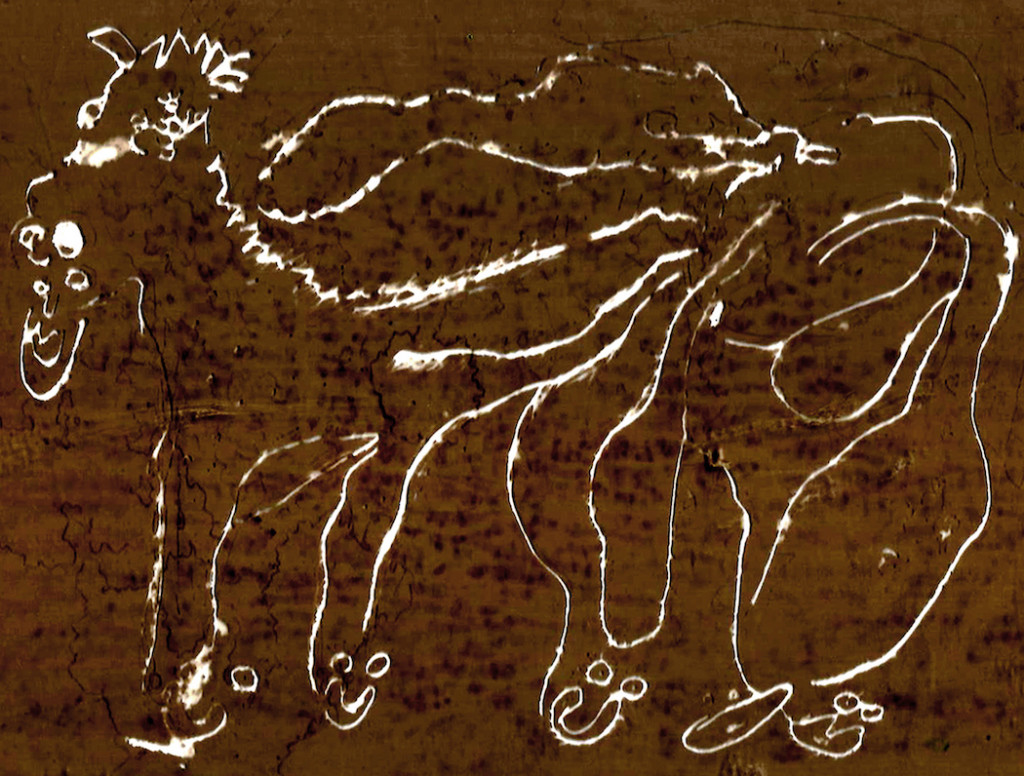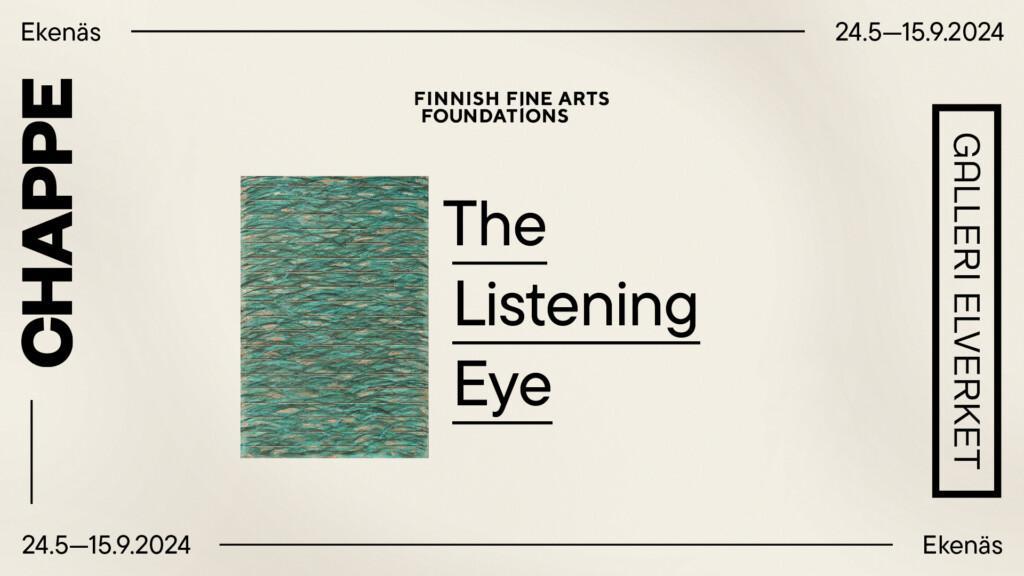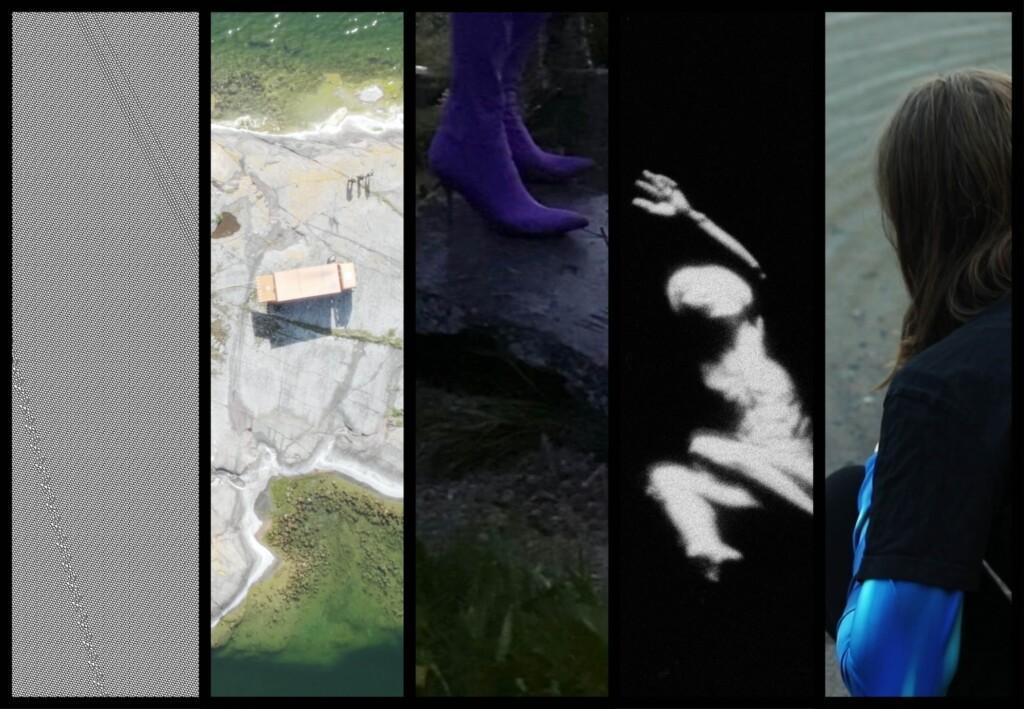
Nomadic Kiln Group, Seed Potato Horse and Smiling Hooves, collectively drawn sketch, clay wheat slip on glass.
The exhibition takes its inspiration from the meditation room installed at United Nations Headquarters in New York in 1952, which UN Secretary-General Dag Hammarskjöld made his own, personal project, completing it with a group of artists and craftspeople in 1957. Regel 62 at Sinne is a spatial study and consists of three site-specific sets of works that communicate with each other, and which in one way or another are linked to the task that – in the shadow of the Cold War – was begun in the ’50s and focussed on peace and the future. The main materials in the exhibition are clay, yarn and sound. The artists are Moa Cederberg, Mikko Kuorinki and Nomadic Kiln Group (Monika Czyżyk, Elina Vainio & Eero Yli-Vakkuri).
In the UN General Assembly Rules of procedure, Rule 62 states that sessions of the General Assembly will open and close with an invitation to a minute of silent prayer or meditation – a procedure that is still followed today. Already in the 40’s, Trygve Lie – first UN Secretary-General – had approved a room dedicated to silence and meditation to be installed in the UN’s temporary Headquarters at Lake Success, Long Island NY. When designing the new Headquarters, it was also laid down that the building should include “A Room of Quiet”. But there were no architectural plans for the room, instead, one of the existing, unallocated rooms in the visitors’ lobby of the General Assembly Building was chosen. The work was done quickly and was more temporary in nature. In comparison with the rest of the finished building this was not to the room’s advantage. Nevertheless, it met with a warm reception both inside and outside the organization, confirming that there really was a need for a room of this type.
Dag Hammarskjöld – second UN Secretary-General – understood the importance of the meditation room and wanted to make it the centre of the UN. Consequently, he embarked on renovations that remodelled it into its final, august form. He did so in close collaboration with the Laymen’s Movement, which was active in giving UN representatives spiritual guidance. A key part of the process was seeing the room as an important and necessary element of the work done in the building. The UN is a workplace where humanity’s most tragic sides and actions are dealt with, and solutions sought. Hammarskjöld, who was interested in the spiritual and conversant with the visual arts, philosophy and poetry, chose to exclude any symbols or signs that could be associated with religions. Instead, he sought an expression and an atmosphere that would help everyone to find stillness and to get in touch with their inner void. He believed people could find strength there for political resolve.
The finished room was made using a considered, spare, modernist approach, and it is still there at UN Headquarters in NYC. It is V-shaped, so that it tapers inwards. At the far end is an abstract fresco by the Swedish artist Bo Beskow, in the middle of the room is a 6-ton black block of Swedish iron ore, and on the floor at the entrance is a rug made by the Swedish textile artist Edna Martin. Arranged on the rug, which extends a little into the room, are benches designed by Carl Malmsten.
In today’s global political situation, it feels apt to turn our gaze back in time to the creation of precisely this meditation room, which serves as a tool in our quest for consensus and vision from a global perspective. The Regel 62 exhibition at Sinne is an attempt to remind people about silence and stillness, and to look at our spiritual resources, at how we can meditate and find pathways. This theme has served as a point of entry to a dialogue with the participating artists, from whom work ideas have then emerged. The intention has been to unwrap and expose the simple, pure, and occasionally primitive. We have looked at materials, techniques, crafts and processes that sustain the meditative. The intention is not to turn the gallery into an ecumenical space as such, but to create an exhibition that captures and reflects the energy that Hammarskjöld set in motion.
Markus Åström
Curator
Moa Cederberg’s installation is a study in time and material. Her textile working method is based on yarn that she has hand-spun herself from wool, nettles and rose fibres. She uses the qualities of the different fibres to play with the sheen, lustre and strength of the yarn. Here she shows effect yarn stretched taut in fine warps. The idea for the work originated in a series of experiments that she made on a residency on Kökar in 2022. There she was inspired by the patterns and structure of the granite cliffs. By adjusting the thickness and colour of the yarn as she spins, she can work up rhythmic variations. When the yarn is stretched into parallel lines in a warp, a kind of image surface arises, a semi-transparent pattern reminiscent of granite and stone. These warps made of lines of yarn are displayed strung between floor and ceiling, under and through each other, so that they create a spatial depth. Cederberg also works so as to make parts of the different image surfaces appear like echoes or reflections of one another.
Moa Cederberg lives and works in Malax. She works with textiles and focuses on spinning her own yarn. She sees this as a meditative process in which she transfers moments and feelings to a physical thread. At the same time, this is work that puts her in touch with tradition and culture. It opens up an understanding of the craft and its position in life and the everyday.
Mikko Kuorinki’s sculptural sound work Recitation makes use of the gallery floor. He builds on the work that he showed with Marja Ahti in 2022 in the exhibition Tulip Antenna at K17 in Nikkilä. Here Kuorinki focuses on transmitting sound into material, and on out into the room. His medium is transducer speakers, wooden boxes and found objects. The speakers activate the different sculptures, whose varied shape and physical compositions give them each their own voice. Kuorinki emphasises recitation as a gateway to working with sound in an exhibition that is to a great extent built around meditation and silence. He focuses on the bodily experience of reciting in a group. The sculptures act together in a similar way, sometimes they are mute and sometimes they can find a harmony, only to diverge again and go out of tune. The sound image includes field recordings, sine waves and noise. Some of this audio material has been recorded in the gallery space, with Kuorinki thus creating a loop in which the room’s acoustics resonate with itself.
Mikko Kuorinki lives and works in Espoo. He works with installations, exhibition entities and publications. Kuorinki’s art is strongly rooted in objects and text, and has a kind of documentarism at its core. He works with an openness to everything he comes across. Rubbish, objects, rooms, song lyrics and other seemingly mundane or insignificant items can become an entry into to new mysteries and ideas.
Nomadic Kiln Group (NKG) utilises the gallery’s large windows. The artwork 💨 Planetary Consciousness Massage Behind the Ears of the Thousand Winds and Statues of Fire 🌋 is a direct development of the work that group member Monika Czyżyk began together with the artist dylan ray arnold and which she further explored during her residency at Schloss Solitude in Stuttgart, Germany. The work is a set of five window paintings painted with clay paint. This paint is a mixture of wild clay and wheat glue applied as layers directly onto the windows. The opaque paint screens out life on the street and turns the gallery into an enclosed space. Using hands and different tools on the wet clay, they produce drawings, writings and unknown symbols that let in light from the outside. The motifs reflect how the group works together as a kind of perceptual pedagogical initiative, where they do not take material knowledge for granted but instead emphasize provisional material spirituality, experimentation and play.
Nomadic Kiln Group (NKG) stems from Helsinki and comprises Monika Czyżyk, Elina Vainio and Eero Yli-Vakkuri. The collective was set up in 2021, founded on a common interest in getting in touch with the soil, water, and extreme temperatures. A central part of their work is collectivity: they have held workshops where participants work with local wild clay and build kilns. Their artistic background is in the moving image, installation, sculpture, and performance.
Clays used on the windows have been collected from Kyläsaari, Vartiosaari, Viikki and Savela in Helsinki, Kurängen in Sipoo, and Świętokrzyskie region in Poland.
Current exhibitions
Elverket
Opening hours
Tue 11–17
Wed 11–20
Thu–Sun 11–17
Mon closed
Sinne
Opening hours
Tue–Sun 12–17
Mon closed


